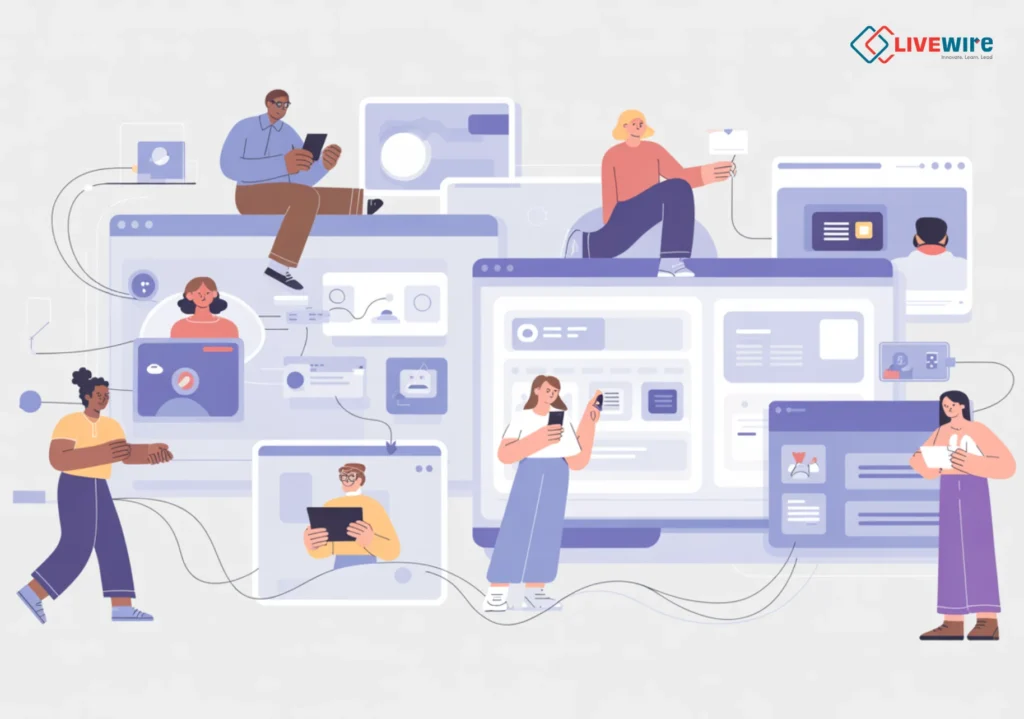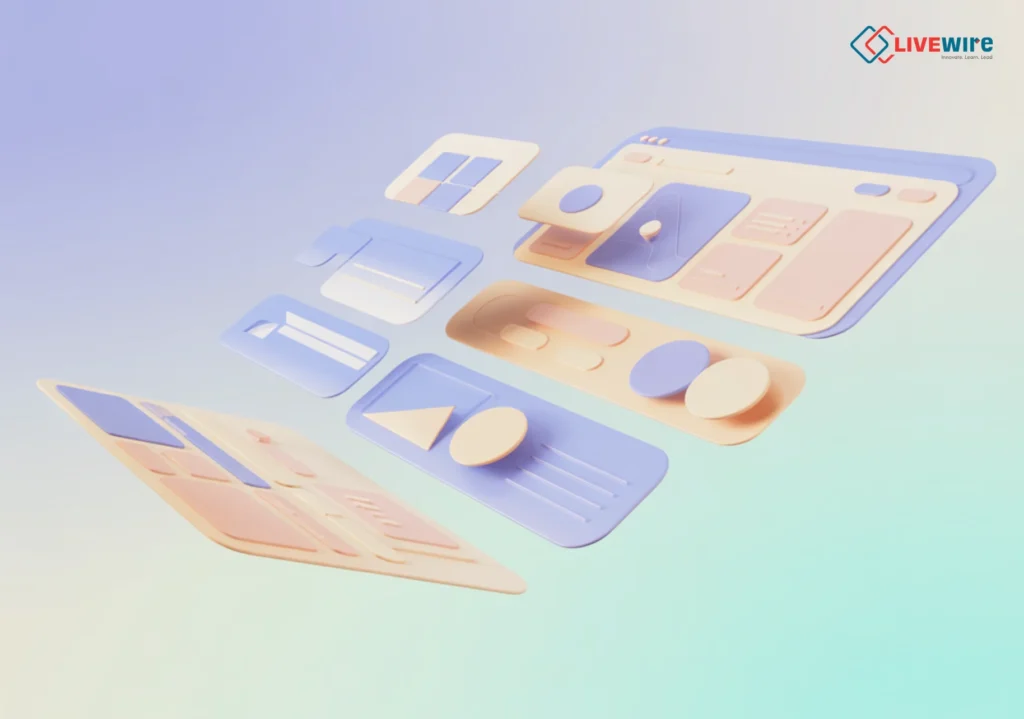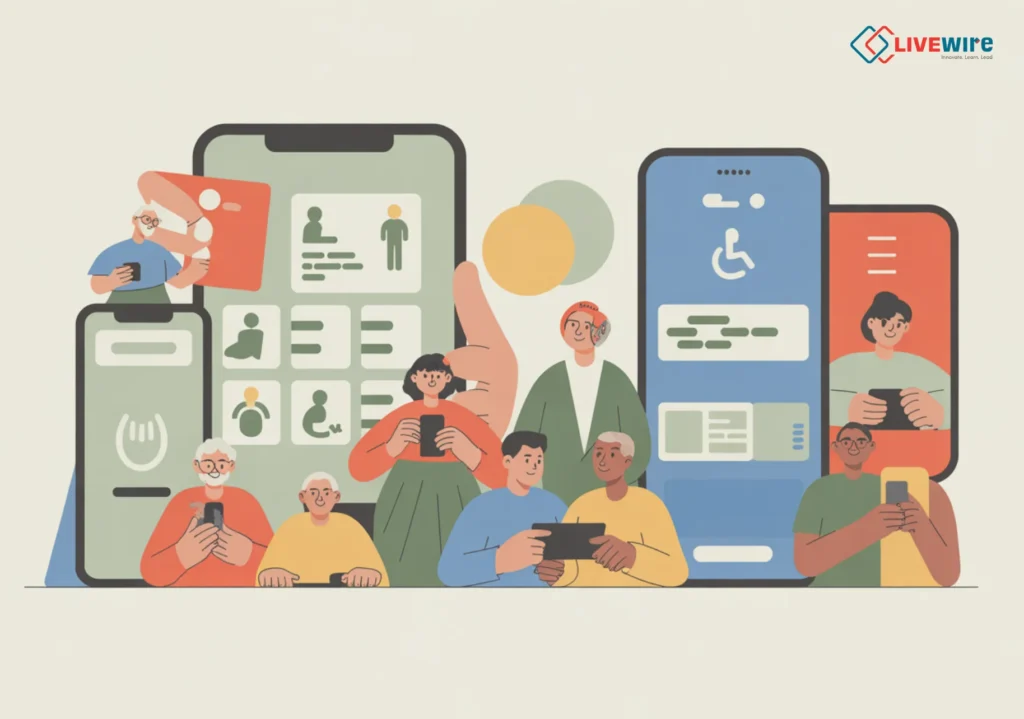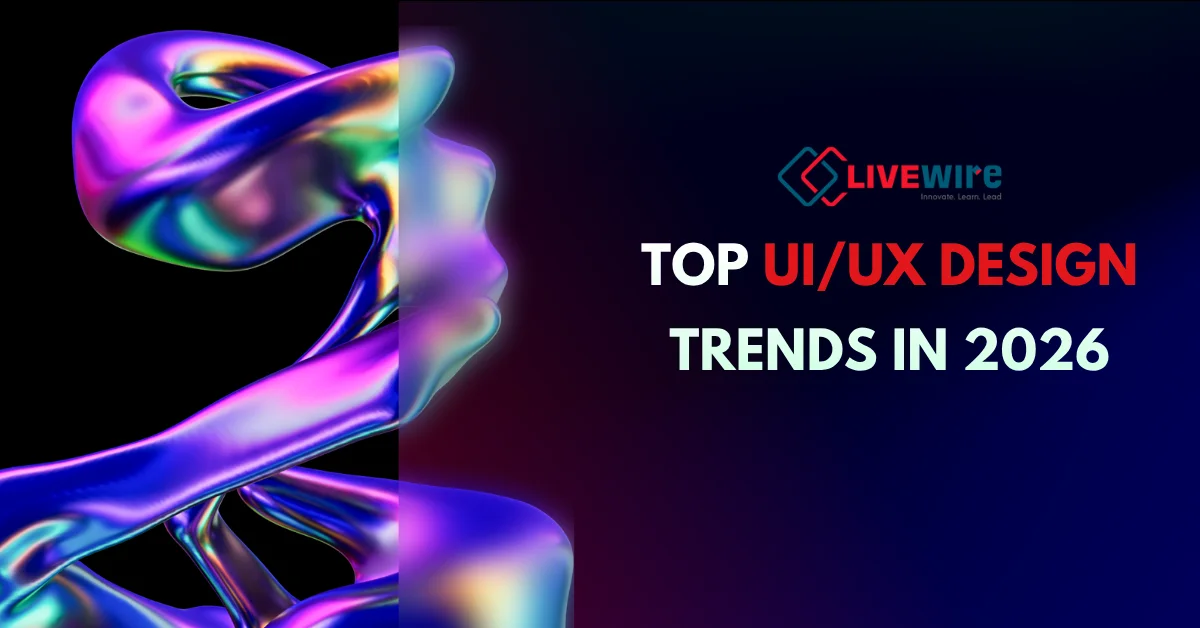With the fast pace of the advancement of technology, the line between human-based intuition and AI involvement in the design of the experience is blurring. 2026 design has radically evolved now it’s not just visual presentation — it’s about potential, predictive, data-informed, inclusive digital experiences. In this blog, we will discuss the best UI/UX Design Trends that changing the way users engage with technology.
From artificial intelligence (AI) based interfaces and personalized experiences to ethical design, these are the design trends that will define innovation and usability in the next few years.
Contents
- 1 Trend #1: AI-Driven UI/UX Design — The Age of Intelligent Interfaces
- 2 Trend #2: Personalization in UX — Customizing Context, Not Just Content
- 3 Trend #3: Conversational & Voice UI Trends — Designing Beyond Screens
- 4 Trend #4: Visual Design Evolution — Calm, Soft, and Spatial
- 5 Trend #5: Inclusive & Ethical UX — Designing for Every Human
- 6 UX Strategy in 2026 — Data, Systems, and Business Impact
- 7 Future of UX Design Careers — Skills, Roles & Tools in 2026
- 8 The Future of User Experience Design — What’s Next?
- 9 FAQs
Trend #1: AI-Driven UI/UX Design — The Age of Intelligent Interfaces

In 2026, AI has moved from being a background helper to a core creative force in UI/UX Design Trends. DesignerIn:t now use artificial intelligence to make digital experiences more predictive, adaptive and context-aware.
Predictive and Adaptive User Experiences
Artificial intelligence isn ’t a background process anymore — it’s a co-designer. In 2026, AI powered UI design is allowing digital products to predict user intent and evolve in real-time. Predictive personalization can make interfaces recommend action, layouts or even content before users asks for it. Think of dashboards that reorganize based on workflow patterns, or apps that automatically simplify complex tasks.
Agentic UX Design — Interfaces That Take Initiative
The month ahead: How Rory has evolved in agentic UX design: redefining predictability One of the most exciting developments in agentic UX design is the movement from reactive to proactive systems. Agentic interfaces are like digital assistants that perform simple tasks on their own such as scheduling a meeting or suggesting actions. This changes UX from a point-and-click experience to a collaborative partnership between interface and user.
Ethical AI and Transparency
Although AI promotes productivity, it also requires accountability. Designers must put ethical considerations first, and make sure that automated processes are transparent and controllable from the dais. Trust continues to be the foundation of great user experience design, therefore straightforward microcopy and consent lead workflows are vital in retaining trust when it comes to ai based systems.
AI is no longer just a tool — it’s a design partner. As AI evolves, so will AI-based UI design, which will define how intelligent and responsible users interact with technology.
Also Check This: UI UX Design Course With Placement
Trend #2: Personalization in UX — Customizing Context, Not Just Content

In 2026, the aim of personalization is to create relevance and not just recognition. The latest UI/UX Design Trends are prioritising contextual and behavior-driven experiences where the end results feel more natural and human.
Hyper-Personalization Using Behavior Data
UX personalization has evolved beyond just showing a user’s name or their preferences. Utilizing real-time behavioral information, products can modify layouts, recommendations, and tone to suit the user’s needs. Faster decisions, increased engagement and a better sense of relationship between the brand and the user is the outcome of this.
Privacy versus Personalisation
However, the difficulty is to preserve the privacy without sacrificing the personalization. Transparent data harvesting and configurable privacy options have become super sets. Users want control over how their data is used to shape their personal experience — and the more ethical brands are living up to that expectation with honesty and clarity.
Real-World use cases
From Netflix’s recommendations to Spotify’s AI-created playlists, user interface design is increasingly governed by prediction systems. As personalization continues to evolve with technology, we will see it become more the norm – not the luxury.
Personalization in 2026 is not to show more – it is about showing what matters. Smart design will personalize every digital interaction based on its users’ preferences and needs without needing to borrow any of their data.
Also Check This: Artificial Intelligence Training in Chennai
Trend #3: Conversational & Voice UI Trends — Designing Beyond Screens

Voice UI and conversation design are changing the way users interact with technology. In 2026, voice UI trends will take over as the human and natural interfaces.
Voice-First Interface Uprisings
Users are opting for screenless interactions as voice UI trends continue to grow. The evolution is being fueled by smart homes, vehicles, and wearable technology that makes communicating through natural speech effortless. Voice is more accessibility-friendly and convenient, allowing users to instinctively connect with devices.
Conversational Interface Design
Designers predict 2026,” Is the dichotomous digital/digitized communication dominated by conversational interface design. AI chatbots and virtual assistants have improved the context-awareness aspect, making the conversations much smoother and more human-like. Designers are building systems that now understand tone, emotion and cultural nuance.
UX Copywriting Best Practices for Conversational Design
A good conversation experience requires wellthought language. Adhering to UX writing best practices, including being clear, concise and empathetic, will help ensure your messages come across as human and relatable content. Microcopy that reflects human speech increases trust and encourages interaction.
UX’s future is conversational. Rather than screens, natural dialogue will become the most intuitive way to access digital experiences.
Trend #4: Visual Design Evolution — Calm, Soft, and Spatial

As users seek equilibrium and tranquility in virtual environments, 2026 introduces a new digital visual ideology. Enjoy the tranquility of the latest UI/UX Design Trends with sensory-friendly design.
Soft UI & Glassmorphism 2.0
Minimalism in design is forever classic. UI/UX Trends 2026 use soft shadows, gradients, transparencies on layers that adds depth without negatively impact on the readability of the content. The effect of Glassmorphism 2.0 is similar to that of 1.0, but this time with Light and reflections that are tactile yet non-intrusive.
3D, AR and Immersive Visual Design
Immersive storytelling is taking center stage. With user interface design merging in augmented reality (AR) and 3D motion, users can interact with digital worlds that feel more like physical ones. These experiences bring emotional engagement to every flick and tap.
Calm Design and Anti-Over stimulation
Calm design focuses on the mental well-being impacts of sensory overload. The designers are focusing on simplifying the user interfaces by removing unnecessary animations and employing white space strategically to enable users to keep their attention on the real essentials.
The visual design of 2026 is less about showing off — and more about taking it slow. It emphasizes feeling emotionally comfortable, having depth, and achieving balance throughout all digital touchpoints.
Also Check This: 10 Essential Skills Every UI/UX Designer Must Have
Trend #5: Inclusive & Ethical UX — Designing for Every Human

The design world is trending towards more empathy. The next generation of UI/UX Design Trends Welcomes the Era Where Every Human -No Matter What They Are Capable of Doing, What Background They Have, Where They Are Located, or Any Other Reason- Can Access and Use Digital Experiences in the Same Manner.
Accessibility Becomes Default
Inclusion isn’t a “nice to have” – it is a “must have”. UI/UX Design Trends 2026: Accessibility by Default – is taking over the industry, because it’s time to make digital experiences accessible to everyone. Complying with worldwide usability standards guarantees anyone can meaningfully use your site.
Designing for Neurodiversity and Global Audiences
Designers are catering to neurodiversity and cultural sensitivity — and multi-lingual supports. Variable fonts, regionalized layouts, and sensory-friendly feedback loops establish fairness throughout the globe.
Ethical & Sustainable Design Principles
Inclusivity isn’t the only ethical area covered. Green design now means cutting energy-intensive components like auto-playing videos and dark-pattern-ux. Morally sound decisions in user experience design are indicative of a brand’s integrity and long-term user trust.
Inclusive design is not going out of style! As brands turn outwards to empathy and ethics, digital experiences are finally going to be truly human-first and human-centric.
UX Strategy in 2026 — Data, Systems, and Business Impact
UX strategy has evolved past “nice to have” look and feel in 2026 — it is the key to and the enabler of business results. According to the latest technology outlines for UI/UX Design Trends, it is a more clearly defined focus on data integration, system thinking and measurable outcomes. Designers are no longer solely producing interfaces, rather entire digital ecosystems that generate revenue, hold retention, and brand trust.
System Thinking in Design
System thinking enables designers to consider the digital products as a system within a system. It provides seamless/consistent experience across device, channel and touchpoints – helps form a cohesive/unified & predictable user-experience design system.
Data-Driven UX Optimisation
Analytics, behavioral heat maps, and AI insights are helping to advance data-driven UX optimization. This allows teams to take educated design decisions, test assumptions more quickly, and iterate on experiences that produce quantifiable business value.
Aligning UX with Brand and Business Goals
The most successful brands now combine UX strategy with business strategy. Every decision in design — interface layout, microinteraction knowing user is looking at KPIs like adoption rate, retention, and brand love.
In 2026, the UX strategy is not a support function; rather, it is the growth driver. By combining information, systems thinking, and business objectives, organizations can transform user experience design into a quantifiable business advantage — one that fuels innovation and delivers the most compelling customer experiences.
Future of UX Design Careers — Skills, Roles & Tools in 2026
Technological advancement is changing not only what we design, but who designs. The future of UX design career paths is more fluid today than ever before in 2026. Designers must now straddle art with data, psychology, and artificial intelligence. With automation taking care of the repetitive work, human-focused creativity, ethical thinking, and strategic insight will be the real points of differentiation.
New faces in design ecosystem
New practitioner types – AI-UX Strategists, Conversational Designers, and Design Ethicists – are evolving the very notion of what it means to be a designer.” These experts marry data fluency with empathy to keep digital experiences human-centered.
Skills Every Designer Should Master
To keep up, designers need to understand systems thinking, AI-enabled UI design, storytelling with data, and emotional intelligence. The importance of ‘soft’ areas such as teamwork and ethics is just as great as that of technical knowledge.
AI Tools That Boost Creativity
Rather than taking the place of designers, AI tools lend them power. Figma AI, Midjourney and other platforms are now automatically handling prototyping or ideation, freeing designers to concentrate on strategy, emotion and invention.
In 2026, design careers are no longer confined to pixels and wireframes — they’re about defining the future of human-computer interaction. The best designers will be those who successfully fuse creativity with technology to elevate user experience design into a driving force for innovation, inclusion, and business growth.
Also Check This: Top 10 UI UX Design Institutes in Chennai for Training & Placement
The Future of User Experience Design — What’s Next?
Looking at post 2026, the future of user experience design is the packaging of human desire and smart technology. The next wave of UI/UX Design Trends revolves around empathy-based automation, adaptive environments, and experiences that preempt user demands while being ethical and inclusive. Both companies and creators have to get ready for a world where design choices are as much about strategy as they are about creativity.
Human and Machine Empathy Together
These interfaces will increasingly recognize human feelings and adjust to them, fostering a user-system partnership. Empathetic AI will allow users to design experiences that are intuitive, reactive and customized.
Ways for Business to Stay Ahead
Progressive organizations will welcome testing, learning, and AI-driven insights. With design thinking at their core, businesses can predict trends and meet user needs to stay ahead of the competition.
Final Takeaway
So it’s not just about technology — it’s about how you understand people more profoundly.” Looking further ahead, the best user experience design will marry intelligence with empathy to ensure digital experiences are meaningful, inclusive and ready-for-now.
Collaboration, Adaptability and Human-Centeredness will shape the future. Rhett Krawitt, CEO of Peerfit said those who seize these principles will drive the development as to not only be ground-breaking in their efforts, but in a manner that is dynamically transformative,” confirming that UI/UX Design Trends should be considered a driver for both business and user success.
As we move into 2026, UI/UX Design Trends are establishing new norms of digital creativity. From agentic UX design to voice UI trends and personalization in UX, the focus is clear: empathy, inclusivity and intelligence. The next generation of digital experiences will be defined by the designers that can successfully balance technology with humanity.
FAQs
Agentic UX design is a class of systems that can act for the user — autonomously predicting and interpreting user needs. This trend adds to the efficiency and engagement of users in 2026 as they are turned into process-conscious partners!
Personalization in UX connects to people on an emotional level. Customized content and UI makes users feel someone understands them which leads to better end-user satisfaction and retention.
Minimalism is not dying, it’s transforming and becoming ‘calm design’ which is a meeting point of simplicity and emotional warmth. This change is all about redressing the balance, not cluttering up the scale.
With transparent consent mechanisms and by enabling users to control their data. Responsible personalization is one that respects boundaries, is appropriately invasive, and improves on the relevance.
The explosive growth of AI-based tools such as Figma AI, Midjourney, or research copilots is revolutionizing the user interface design process by allowing for quicker, more innovative work flows.
